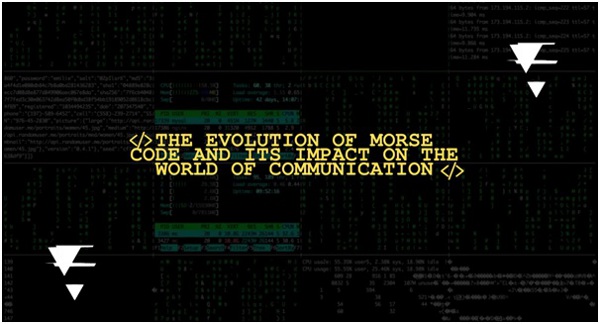The Morse code communication technology uses a series of dashes and dots to send messages. Based on the fundamental Latin alphabet with additional Latin letters, Arabic numbers, and punctuation, there is an International Morse Code.
In International Morse Code, every character is represented by a different combination of dots and dashes. An experienced eye or ear can read Morse code. The invention of Morse code telegraphy dates back to the 1800s. This outdated text messaging system is still helpful.


It was used to spread important public messages during global conflicts. Mail delivery between continents could be facilitated by it. Texting was around before Morse code, in a way.
These days, smartphones, fast internet, and instant messaging apps are ubiquitous. Here, we talk about the Morse Code’s profound impacts on communication.
What is the Morse Code?
Two distinct systems are associated with Morse codes. In Morse Code, dots, dashes, and spaces represent letters, numerals, and punctuation. In addition to similar mechanical or optical signals, the codes can be transmitted as electrical pulses of different durations. There are two codes: the “American” Morse Code and the more often-used International Morse Code.
How does the Morse code work?
A unique configuration of short dashes and dots represents every letter in the International Morse Code. The International Morse Code uses constant-length dashes in place of the variable-length dashes used in the original Morse Code. For instance, three dots, three dashes, and three dots are the alphabet for the universal distress signal “SOS,” where three dots stand for the letter S and three dashes for the letter O.
Every letter in the alphabet has a distinct code assigned to it by this system. For example, a dot can stand in for the letter “E,” and a dash for “T.” To speak with them, you must be conversant with their codes.
This system is extremely important; it cannot be overstated. Global telegraph communications became the norm with it. In the 20th century, it was also crucial for maritime communication, which helped to avert maritime tragedies.
The History of Morse Code
Electrical transmission techniques were only beginning to be investigated by scientists and engineers in the early 1800s. The electrical telegraph system was invented in 1836 by Alfred Vail, Joseph Henry, and Samuel Morse. It was the pioneering system that enabled communication across great distances. The issue was that it could only communicate with other machines via electrical pulses.
You were thus unable to text or speak with someone. Therefore, a new channel of communication was required. The code was created by Samuel Morse himself to convert electrical pulses back into the original message. Electrical pulses, both short and long, were coded using letters and numbers. These pulses would later be referred to as dots and dashes.
In the beginning, Morse’s code solely used numbers. Even though this was effective in conveying certain information, it was not enough to build a robust communication capability. Vail assisted in extending the code to incorporate more letters and special characters. Thus, the Morse Code was created.
Morse Code Evolution and Modern Technology in Communication
Humans have a natural need to communicate with one another. Not only has functionality and appearance evolved, but communication has also progressed. The smoke signal was one of the first methods of long-distance communication.
The debate has been significantly impacted by the usage of a Morse code translator. Its numerous advantages make it a tempting choice in various circumstances. Morse code allows for more accurate and speedy communication. Users are able to send data quickly and precisely.
The advancements made by previous generations made possible important inventions such as the telephone and the internet. The most important modes of communication are listed below.
The invention of radio


The mass communications period began with the invention of the radio, telephone, and television. Nevertheless, many homes were unable to purchase any. Despite its decline, the newspaper remained the most popular medium for communication. The newsletter’s low cost—just two cents per copy—contributed to its enduring appeal.
Telephone
The invention of Morse code was one of the most significant technological advancements of the late 1800s. None, though, was quite as revolutionary as Alexander Graham Bell’s invention of the telephone in 1876. It took off as a highly valued formal, corporate, and personal communications instrument.
Satellite
Two very important developments in global communications occurred in the 1960s. With satellite communications, people may access more television stations and get weather information. As it happened, 500 million television watchers witnessed Neil Armstrong’s historic 1969 lunar landing via satellite.
Internet
The mid-1900s saw a rise in the popularity of television as a need in households as people started to love viewing color television. With the advent of the Internet and the subsequent creation of email, computer technology advanced. Many people believe that email is currently the most significant and popular Internet application.
The Future of Communication
There isn’t a conversation about communication in the future these days that doesn’t mention 5G.
By 2024, 21 percent of mobile connections worldwide are expected to be 5G. New services will enhance our communication is technology, and one another will be made possible by its connectivity.
5G offers a powerful combination of improved power efficiency, decreased latency, increased bandwidth, and remarkable speed, which makes it perfect for object connectivity. Our cities will grow smarter as a result of our increasingly immersive entertainment.
Wrapping Up
In the 19th century, Morse code and the telegraph significantly changed long-distance communication. Its widespread use has decreased, yet it is still an important aspect of technology and cultural history. The development of the Morse Code had a significant impact on communications history. It was essential for communication all over the war, helped people communicate across long distances, and had a lasting impression on popular culture.

























